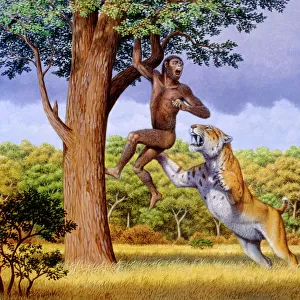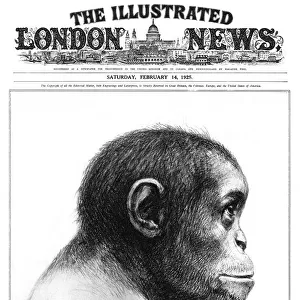Poster Print > South America > Related Images
Poster Print : 1825 Watertons Taxidermy Nondescript
![]()

Poster Prints from Science Photo Library
1825 Watertons Taxidermy Nondescript
1825 " A Nondescript" drawn by T.H. Foljambe engraved on copper (with later tinting) by I.W. Lowry, being the frontispiece to Charles Watertons " Wanderings in South America" J. Mawman, London (1825). The specimen is derived from a howler monkey (some say its head, others its rump) and shows Watertons unique skills and method of Taxidermy which employed a sublimate of mercury and hollow specimens, to reform shape. It is clear from Watertons own jocular account that it was a prank. He is said to have admitted in later life that it was given the likeness of J.R. Lushington, secretary to the UK Treasury who had levied heavy import duties on his specimens. But Watertons own account strongly hints at two more serious motives for the hoax. To prove his unrivalled skills at taxidermy and to make the point that a monkey cannot be turned into a man (this question was argued long before Darwin)
Science Photo Library features Science and Medical images including photos and illustrations
Media ID 6346181
© PAUL D STEWART/SCIENCE PHOTO LIBRARY
Evolution Fake Fraud Hoax Mercury Monster Taxidermy Howler Monkey Waterton
18x24 inch Poster Print
Bring the captivating world of natural history into your home with the Media Storehouse range of Poster Prints. This stunning piece showcases "1825 A Nondescript" by Paul D. Stewart from the Science Photo Library. Originally drawn by T.H. Foljambe and engraved on copper with later tinting by I.W. Lowry, this print was the frontispiece to Charles Waterton's "Wanderings in South America". With its intricate details and timeless charm, this poster print is a must-have for nature enthusiasts, collectors, and those who appreciate the beauty of the natural world.
Poster prints are budget friendly enlarged prints in standard poster paper sizes. Printed on 150 gsm Matte Paper for a natural feel and supplied rolled in a tube. Great for framing and should last many years. To clean wipe with a microfiber, non-abrasive cloth or napkin. Our Archival Quality Photo Prints and Fine Art Paper Prints are printed on higher quality paper and the choice of which largely depends on your budget.
Poster prints are budget friendly enlarged prints in standard poster paper sizes (A0, A1, A2, A3 etc). Whilst poster paper is sometimes thinner and less durable than our other paper types, they are still ok for framing and should last many years. Our Archival Quality Photo Prints and Fine Art Paper Prints are printed on higher quality paper and the choice of which largely depends on your budget.
Estimated Product Size is 61.6cm x 46.3cm (24.3" x 18.2")
These are individually made so all sizes are approximate
Artwork printed orientated as per the preview above, with landscape (horizontal) orientation to match the source image.
EDITORS COMMENTS
This print showcases the intriguing "1825 Watertons Taxidermy Nondescript". Drawn by T. H. Foljambe and engraved on copper by I. W. Lowry, this piece served as the frontispiece to Charles Waterton's renowned book, "Wanderings in South America" published in London in 1825. The subject of this peculiar artwork is derived from a howler monkey, although there is debate about whether it depicts its head or rump. What makes this taxidermy specimen truly remarkable is Waterton's unique method, which involved using a sublimate of mercury and hollow structures to reshape the animal. However, it was later revealed that this creation was nothing more than an elaborate prank. Rumor has it that Waterton crafted the likeness of J. R. Lushington, secretary to the UK Treasury who had imposed heavy import duties on his specimens. Yet beyond mere mischief, there were deeper motives at play here. Through his jocular account and subsequent admissions, Waterton aimed to demonstrate his unparalleled taxidermy skills while also making a profound statement: no matter how skilled one may be at manipulating nature through artifice like taxidermy, transforming a monkey into a man remains an impossibility. This fascinating image raises questions about human evolution long before Darwin's time and delves into themes such as fraud and deception within scientific circles. It serves as both an artistic masterpiece and a thought-provoking historical artifact that continues to captivate viewers with its intricate details and complex narrative.
MADE IN THE USA
Safe Shipping with 30 Day Money Back Guarantee
FREE PERSONALISATION*
We are proud to offer a range of customisation features including Personalised Captions, Color Filters and Picture Zoom Tools
SECURE PAYMENTS
We happily accept a wide range of payment options so you can pay for the things you need in the way that is most convenient for you
* Options may vary by product and licensing agreement. Zoomed Pictures can be adjusted in the Cart.







